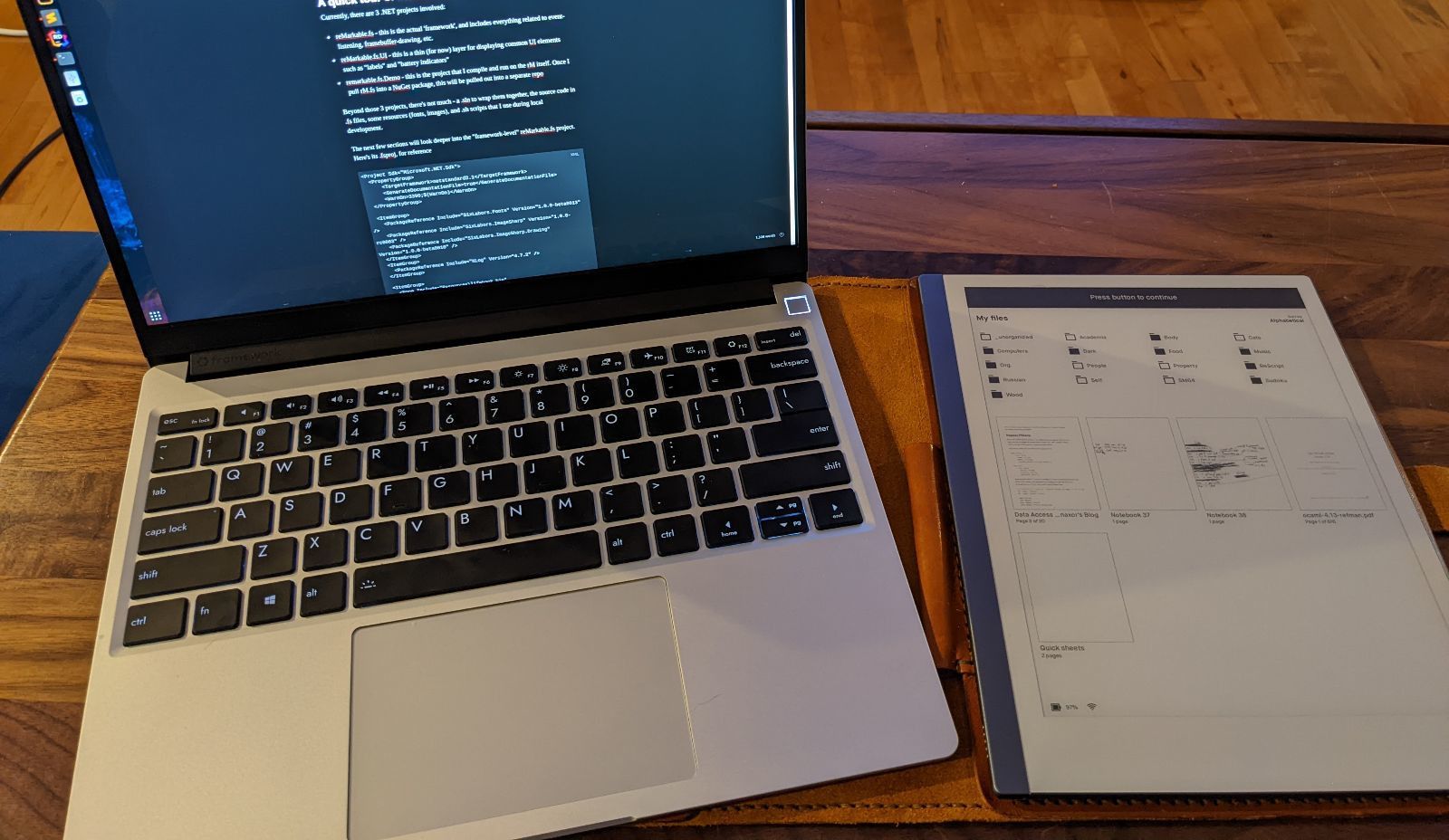Intro to reMarkable; Motivation; Getting Started

This is part 1/3 in a series "Hacking the reMarkable eInk Tablet."
Summary:
- The reMarkable 2 is an 18.8*24.6cm (7.4*9.6in) eInk Linux tablet that I use as a daily driver for taking notes, reading books, drawing diagrams, doodling, etc.
- I'd like to extend my use of the hardware by writing custom software for it.
- In this post, I cover the device itself, my use cases and motivations, a primer on getting familiar with the software+hardware.
- In part 2, I cover the the existing reMarkable hacking ecosystem as far as I know it.
- Part 3 covers a hobby project of mine - a WIP framework for building custom reMarkable apps, with F#
What are its marketed use cases?
taking notes, reading and notating eBooks, drawing art and diagrams.
there are some extensions to the device's hardware, such as document export, cloud sync, and OCR for notes
Why I love it, other potentials for the hardware, things I want to build
- gorgeous hardware, with enough specs and a base of Linux that makes it perfect for hacking
- eInk screen to save my eyes after my day job, while still having access to the digital world
- feels like paper - the power of a computer, without feeling like you're _on the computer_
- a long battery life, compared to other computers such as laptops and iPads
- friendly to distraction-prone brains; allows one to detach from notifications/alerts
If you're interested in a thorough guide of the reMarkable's base hardware and software, "My Deep Guide"'s review of the rM2 is well done.
Hardware accessories
Styluses / Pens
When you buy a reMarkable, you can/should also buy some sort of stylus/pen to write with. There are several official ones sold by reMarkable on their website, but it's worth noting that there are unofficially-compatible styluses as well. The official pens are great, but pricey, so worth looking around. (Personally I find the official Marker Plus to be worth it)
Cases / Folios / Stands
Similarly, the reMarkable sells thin folios/cases for the rM. They're OK, but don't offer much support. I'd recommend checking out eBay, Amazon, or Etsy for alternatives. I've seen the best options available on Etsy, and love the case I bought from envycase on Etsy. The wiki also lists some options.
Other
"Book lights" are meant for reading physical books at night, and come in handy occasionally.
If you plan on doing a lot of diagramming, getting a soft plastic (to not scratch the surface) ruler or other device to assist in drawing may be worthwhile.
Alternative Devices; Considerations to Make
The reMarkable does not exist in a vacuum, and may not be the best device for you. While it is hackable, it's not an easy ride.
Especially consider this question: Do you need availability of many apps, or the ability for any developer to make them? If so, look around for Android tablets instead.
I'd recommend "Good e-Reader" as a great place to learn about the available eInk devices.
Built-in Software: Xochitl
The default software is fantastic for taking notes, reading eBooks, drawing from doodles to professional diagrams, organizing your thoughts, etc. If you search for "reMarkable tablet," you'll find a ton of information about it.
A quick caution - you can break your rM!
While the early reMarkable is "hackable," and at one point the rM team actively encouraged such, that hackability comes with no safety nets, and you're likely to break your warranty, and maybe your machine. (hope not!). By default, all access to your rM is root.
(Side note: I broke the warranty on my first machine with an axe...it was an axe-i-dent)
If you do manage to get into a bad/scary state, here's my advice:
- reboot your machine. Multiple times. Hold the power button down for a while, repeatedly, until you see a "starting..." screen
- see if you can ssh into your machine
- If all else fails, visit https://remarkablewiki.com/trouble/start
Diving into the rM's Software Side - Basics
The reMarkable is a Linux-powered computer with ARM processor - so you have quite a bit you can get done! That said, the ARM processor may sometimes leave you not finding ready-to-go binaries for various things
- A good way to get started is to SSH into your machine: https://remarkablewiki.com/tech/ssh. Note that this also opens up the ability to cop files to/from your rM with scp or rclone
- Study the file system a bit. If you're not familar with Linux file systems in general, do that, and then visit the wiki for more rM-specific details
- notes about suspend time
- changing USB IP
- setting the timezone
- mounting rM filesystem on host PC
- customizing splash screens
- listing the processes currently running
- notes about power supply/usage
Community
The reMarkable has a few little communities you might want to check out:
The unofficial reMarkable wiki is a great place to start, and just read around. There's a ton here about getting started with the basics and knowledge of the rM, but doesn't offer much in the way of applications or development.
The toltec package manager was built for the reMarkable specifically. It's based on Entware, and has a bunch of cool packages worth checking out. If you're looking to install a few non-Xochitl applications quickly, focus on getting toltec installed, and play around with the available packages.
There's a RemarkableTablet Subreddit - the discussions here usually aren't very technical (though sometimes they are!), but rather discussions around rM as a company, along with various success/disappointment stories regarding the devices themselves, and artwork to put on the rM.
The reMarkable Discord group is a great place full of both technical and non-technical discussions.
GitHub is a central hub for most rM projects. You can start by peeking at the collaborative awesome-remarkable repo, or by browsing the `remarkable-tablet` github 'topic' and https://github.com/reHackable org.
Heads up: there's another technology project out there called 'remarkable' - some sort of markdown editor or something - anyway, watch out to not be distracted by those projects when browsing.
There's also a reMarkable FaceBook usergroup - I'm not sure what goes on there.
